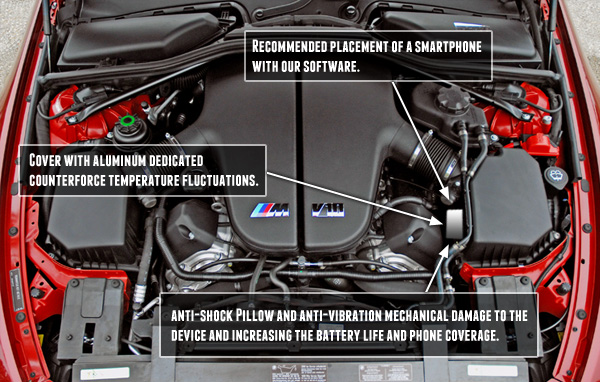
BMW 6 SERIES E63/64 GPS Tracking
Track your 6 SERIES E63/64 for free and visualize it on map
Produced to: NOW
How to track your favourite BMW - model 6 SERIES E63/64 in realtime for free ?
Producer remarks about this particular model
SERIES 6 E63/64 is a second generation of luxury coupes BMW cars. It was presented in autumn 2003.Our product description
We are offering you completely free of charge our GPS car tracking solution in real time. The only thing you need to do is to install smartphone with Android inside your vehicle with our awesome application on board
If you want to track your BMW 6 SERIES E63/64 in real time you have to do the following :
1. Download Free Car Tracking Application for 6 SERIES E63/64 application from Google Play
2. Create free account on spysat.eu (for example johndoe) - here is detailed instruction
3. Define Device endpoint for each vehicle you want to track - give friendly name of your 6 SERIES E63/64 and PIN (some random will be provided - you can change it if you want)
4. Run SpySat mobile application on the smartphone and type there your LOGIN from SpySat (ex. johndoe) and PIN (from point 3.)
5. Install your smartphone inside the car
6. Enjoy watching position of your car at spysat.eu site.
7. Provide stable power supply - spysat app consumes some energy.
Best options to install smartphone inside BMW 6 SERIES E63/64

1. Choose an appropriate mount for your smartphone. You can find mounts specifically designed for the BMW 6 Series E63/64 on aftermarket websites or create your own using materials like rubber or silicone.
2. Install the mount in a location that provides easy access to the phone but doesn't obstruct important controls or visibility. For example, you can mount it on the dashboard near the air vents or on the center console.
3. Connect the wiring from the mount to the car's electrical system using the appropriate connectors. Be sure to consult the vehicle's manual for detailed instructions and ensure that your modifications do not violate any warranty clauses.
4. Install a replacement GPS antenna in the trunk or under the car to improve reception quality. This is especially important when using the smartphone as a GPS tracker application.
5. Download our free app from this website to monitor and control your phone's functionality while driving. The app allows you to set speed limits, customize notifications, and even disable certain functions if needed.
6. Regularly maintain your car by following the manufacturer's recommended guidelines for fluid changes, tire rotations, and oil changes. This will help ensure optimal performance and prolong the life of your BMW 6 Series E63/64.
Remember to always wear a seatbelt and obey traffic laws while using any smartphone as a GPS tracker application. Safe driving!
Users opinions and questions
Frequently Asked Questions:
What are the common maintenance issues and recommended service intervals for a BMW 6 Series E63/E64 model?
The BMW 6 Series E63/E64 models (produced from 2004 to 2010) are known for their luxurious design, powerful engines, and exceptional driving dynamics. However, like any vehicle, they require regular maintenance to keep them running smoothly and avoid costly repairs down the line. Here are some common maintenance issues and recommended service intervals for the BMW 6 Series E63/E64:1. Engine oil changes: BMW recommends changing the engine oil every 10,000 miles or 12 months, whichever comes first. However, if you frequently drive in stop-and-go traffic or extreme weather conditions, it may be necessary to change the oil more frequently. Be sure to use the correct type of oil as specified by BMW for your specific model and engine size.
2. Air filter replacement: The air filter should be replaced every 15,000 miles or 18 months, whichever comes first. A dirty air filter can reduce fuel efficiency and cause damage to the engine over time.
3. Brake fluid changes: BMW recommends changing the brake fluid every 2 years or 40,000 miles, whichever comes first. This is important because old brake fluid can absorb moisture, which can lead to corrosion and reduced braking performance.
4. Transmission service: The transmission should be serviced at 35,000 miles or 6 years, whichever comes first. This involves draining the transmission fluid and replacing it with new fluid. It's also a good idea to have the transmission filter replaced during this service.
5. Spark plug replacement: The spark plugs should be replaced every 30,000 miles or 4 years, whichever comes first. Worn-out spark plugs can cause misfires and reduce engine performance.
6. Coolant flush: BMW recommends flushing the coolant system every 4 years or 60,000 miles, whichever comes first. This helps prevent corrosion and ensures that your car's cooling system is functioning properly.
7. Tire rotation and balance: Tires should be rotated every 7,500 miles to ensure even wear and improve fuel efficiency. Additionally, have your tires balanced whenever you notice vibrations or uneven tread wear.
8. Wheel alignment: Have the wheel alignment checked every 12 months or 12,000 miles, whichever comes first. Misaligned wheels can cause uneven tire wear and reduce fuel efficiency.
9. Suspension inspection: The suspension should be inspected at least once a year to ensure that all components are in good condition and functioning properly. This includes checking for leaks, worn-out bushings, and damaged springs or shocks.
10. Brake system inspection: Have the brake system inspected at least once a year to ensure that there is no excessive wear on the brake pads, rotors, or calipers. This also includes checking for leaks in the brake lines and ensuring that the parking brake is functioning properly.
By following these recommended service intervals and addressing any maintenance issues promptly, you can help extend the life of your BMW 6 Series E63/E64 and maintain its performance and reliability on the road.
Can you explain the differences between the 2015 and 2017 models of the BMW 6 Series E63/E64 in terms of their engine performance, transmission options, and available features?
Certainly! The 2015 BMW 6 Series (E63/E64) came with a few engine options, including a 3.0L twin-turbo inline-six for the 640i and a 4.4L twin-turbo V8 for the M6. The transmission options were an 8-speed automatic for both engines.For the 2017 model year, BMW made some updates to the 6 Series lineup. They replaced the 3.0L inline-six engine with a new 3.0L twin-turbo inline-six in the 640i and introduced a new plug-in hybrid version called the 640i xDrive iPerformance. The V8 engine remained the same in the M6.
In terms of transmission options, BMW added an optional 7-speed dual-clutch transmission (DCT) for both the 3.0L inline-six and V8 engines in the 2017 model year. The DCT offers faster shifts and better fuel efficiency compared to the 8-speed automatic.
As for available features, BMW added some new technology options for the 2017 model year, including a head-up display, wireless smartphone charging, and a rearview camera with parking sensors. Additionally, BMW made some design updates to the exterior and interior of the car, such as new LED headlights and updated interior materials.
How can I resolve the issue of intermittent loss of power in my BMW 6 Series E63/E64 during acceleration?
Check for any faulty components in the engine management system (ECU, sensors, wiring). Run a diagnostic test to identify any errors or codes. Inspect the fuel delivery and filter systems. Make sure they are clean and functioning properly. Check the ignition system, including the spark plugs, distributor cap, rotor arm, and ignition coils. Ensure they are in good condition and working correctly. Verify that the air filter is clean and free from blockages. Replace if necessary. Inspect the exhaust system for any leaks or restrictions. Repair or replace as needed. Check the transmission and clutch systems. Look for signs of wear, such as slipping or grinding during shifts. Examine the braking system, including the pads, discs, calipers, and fluid levels. Address any issues promptly to ensure safe operation. Test the battery, alternator, and charging system. Make sure they are providing adequate power and voltage to the vehicle. Ensure proper maintenance and service intervals for your BMW 6 Series E63/E64 according to the owner's manual. This includes regular oil changes, fluid top-ups, and filter replacements. If none of these steps resolves the issue, consult a qualified BMW technician or mechanic for further diagnosis and repair recommendations.Can you replace the faulty VANOS solenoid valve on my 2006 E63 BMW 645Ci, as it has been causing rough idling and a loss of power at low RPM?
1. Locate the VANOS solenoid valve**: It's located on the driver's side of the engine compartment, near the oil pan. You'll see a small plastic cover held in place by a single screw. Remove the screw and pull off the cover to access the solenoid valve. Disconnect the electrical connector**: Use a Torx screwdriver to remove the electrical connector from the solenoid valve. Be careful not to damage the connector or the surrounding wiring. Remove the solenoid valve bracket**: The solenoid valve is held in place by a small bracket that's secured with two screws. Remove these screws and gently pull away the bracket to access the solenoid valve itself. Disconnect the hydraulic lines**: There are two hydraulic lines connected to the solenoid valve. Use a wrench to loosen the fittings on both lines, then carefully pull them off the valve. Be prepared for some pressure to be released when you do this!5. Remove the old solenoid valve**: Once the electrical connector and hydraulic lines are removed, you should be able to pull the old solenoid valve out of its mounting bracket. Install the new solenoid valve**: Simply reverse the steps above to install the new solenoid valve. Make sure it's properly seated in its mounting bracket and that all connections are secure. Some things to keep in mind when replacing the VANOS solenoid valve:
* Be careful not to damage any of the surrounding components or wiring. Make sure you have a good supply of clean hydraulic fluid on hand, as you'll need to refill the system after installing the new solenoid valve. Consider replacing the hydraulic lines while you're at it, as they may be damaged or worn out. In terms of cost, you can expect to pay anywhere from $500 to $1,000 for a replacement VANOS solenoid valve, depending on the quality and source of the part. Labor costs will depend on your location and the shop that does the work. Overall, replacing the VANOS solenoid valve is a bit involved but doable with some mechanical aptitude and patience. If you're not comfortable with this level of work, it's always best to seek out the help of a professional mechanic.